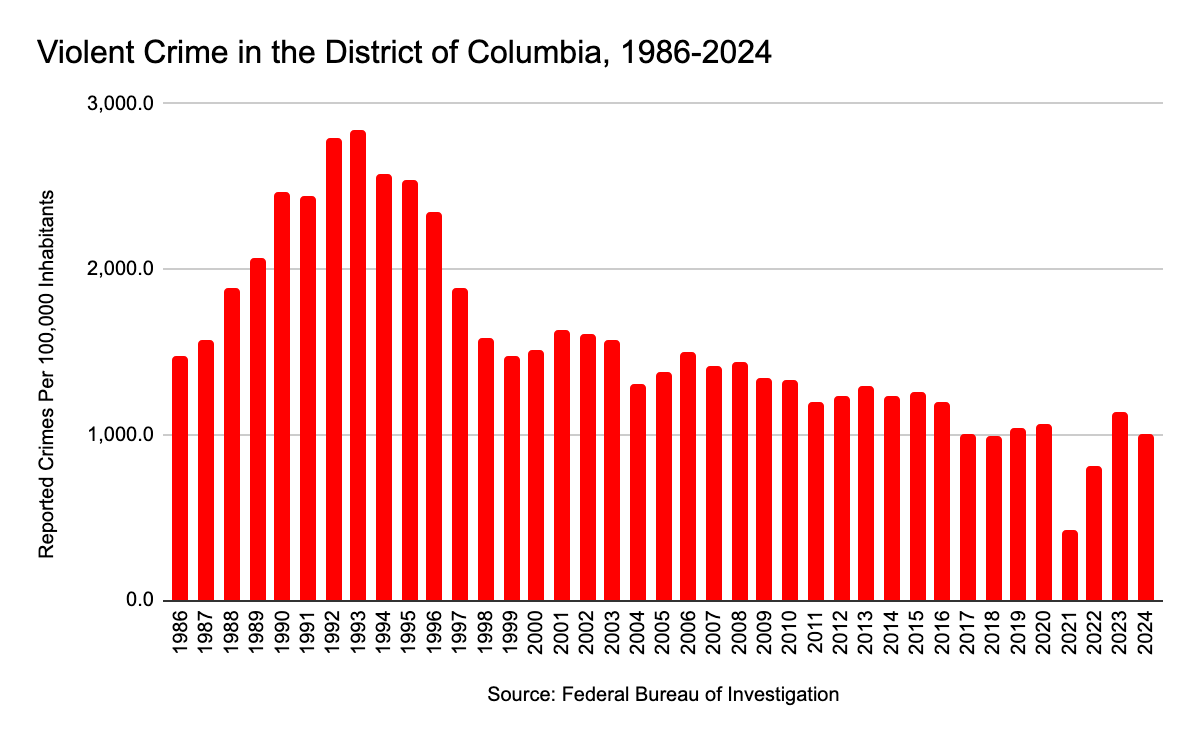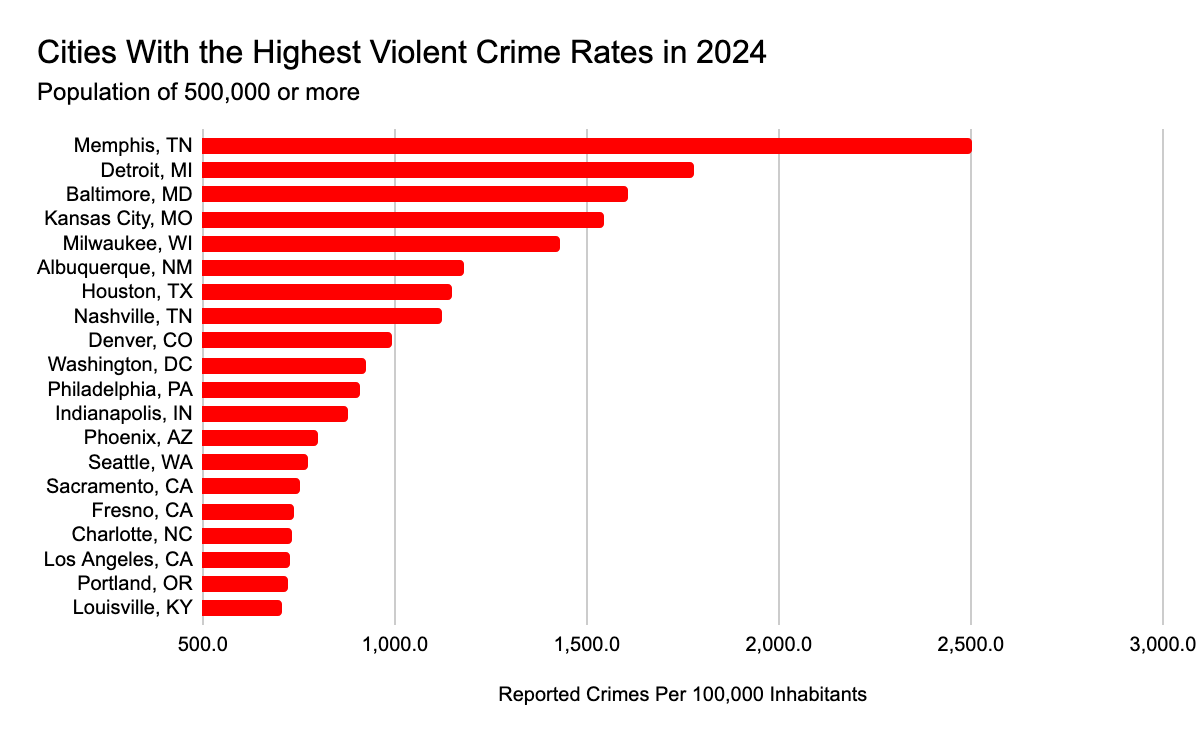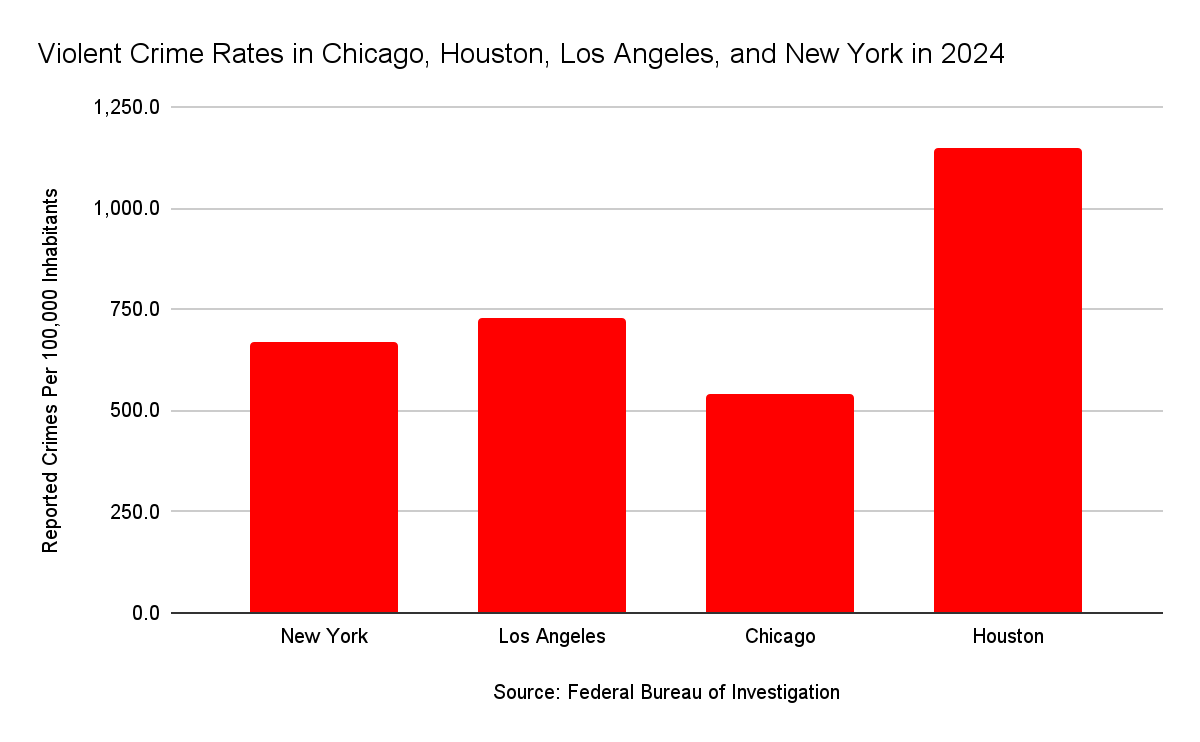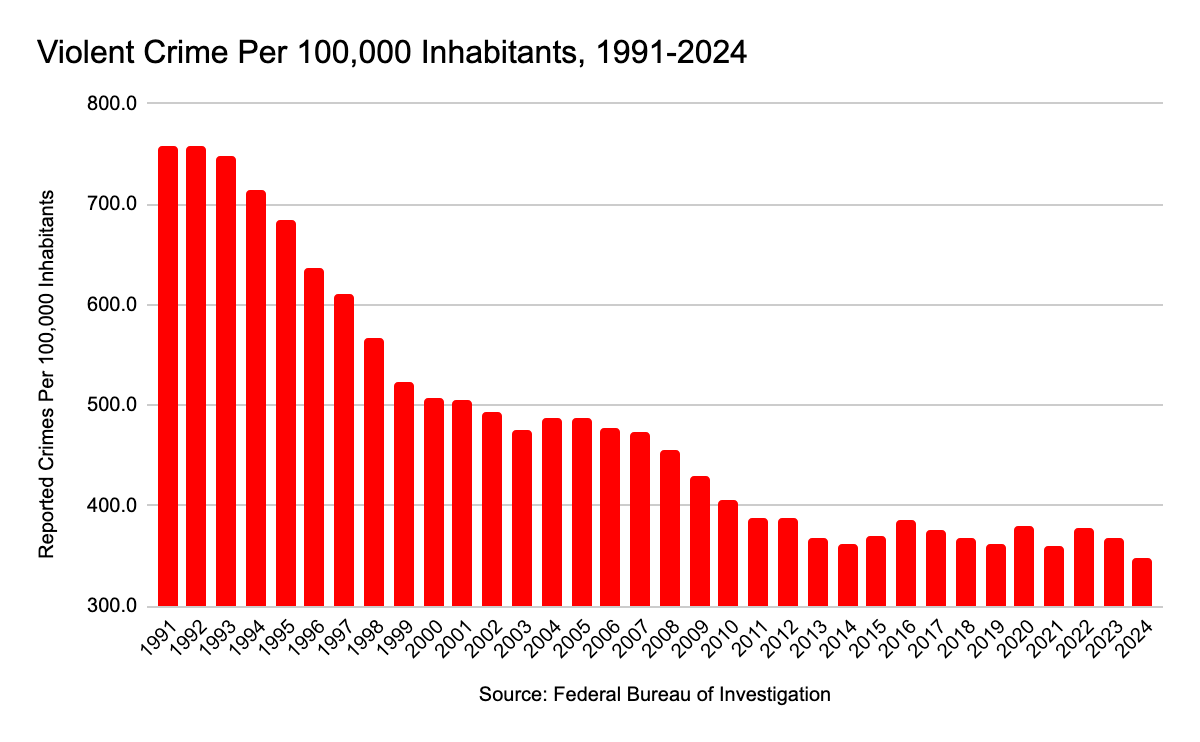The Takeover of the District of Columbia Is Completely Unjustified
Violent crime in the District of Columbia has declined
Crime is a problem in the District of Columbia. Few would say otherwise. But, is it as bad as Trump and others have made it out to be in recent days? Absolutely not. The District has experienced far worse in the past. The violent crime rate in the city is down.1 The District also has better crime numbers than other cities, and its rates are declining far faster than declines in those cities.
Regardless of how one feels about crime in the nation’s capital, however, it is important to not miss the forest for the trees: Deploying federal law enforcement and the military in an effort to restore law and order is not the appropriate nor the most effective way to combat crime of any type. It imperils the devolution of power to local levels, which Republicans typically support, in favor of heavy-handed federal intervention in a way that is not measured and imprecise. This threatens trust in law enforcement more broadly, and risks undermining the very restoration of law and order that Trump’s actions are at least presumed to try to address.
Although Congress formally has jurisdiction over the District of Columbia,2 the District of Columbia Home Rule Act of 1973 empowers the city's residents to govern themselves.3 Congress, of course, may still exercise its jurisdiction over the District, which includes the authority to nullify laws passed by the D.C. Council.4 However, this should be done sparingly, if done at all, and at a minimum done in a careful and coordinated way so as not to disrupt and upend existing policy and norms to which residents of the District are accustomed. After all, the history of the District is long, storied, and significant to preserve.
Congressional Republicans have taken a hostile stance toward the District in recent months.5 In March, the Senate passed the District of Columbia Local Funds Act, S. 1077, which allows the D.C. Council to spend some $1 billion in local funds. The legislation was necessary because Congress controls the District’s budget and apparently forgot to include language to allow the D.C. Council to do this when it passed the full-year continuing resolution in March, H.R. 1968. Although Speaker Mike Johnson (R-LA) said in May that he would bring S. 1077 to the floor in the House, he thus far has failed to do so. The reason? Conservatives want limitations in the District on abortion and immigrant voting rights in the city’s local elections.
The antagonism has accelerated at warp speed in the last few days, culminating in Trump’s invocation of Sec. 740 of the Home Rule Act, federalizing the Metropolitan Police Department (MPD), and announcing the deployment of 800 National Guard troops in the District. There are also agents/officers from other federal law enforcement agencies patrolling areas in the city as per an order that came to fruition in the District last Friday. Trump claims that these actions are necessary because of a “crime emergency” in the District, and that there is a need to “put criminals on notice that they're not going to get away with [crime] anymore.”
Understandably, many residents of the city—and many outside of the city—are frustrated with the heavy-handed oversteps that Trump has taken in recent days to exert his influence over the District. I read one prominent conservative this morning, though, who slammed “white progressives who live in the Northwest section of Washington, D.C.” for “[taking] to the streets to protest Donald Trump’s takeover” of the District. This grievance ignores the point and incorrectly infers that it’s only “white progressives” in affluent neighborhoods complaining or protesting this. It doesn’t really add anything to the conversation, and the fact stands that it’s not true. “Libs owned,” though, I guess.
Conservatives are also complaining about the reporting from media outlets that repeat the claim that crime in the District is at a 30-year low. This comes by way of a press release issued by the Department of Justice on January 3, 2025, in which the former United States Attorney for the District of Columbia touted a 35 percent decline in violent crime, according to data collected by MPD. The same release states, “Total violent crime for 2024…is the lowest it has been in over 30 years.” Not to be a stubborn data nerd, but violent crime in the District is at its third-lowest since 1995. 6The violent crime rate in the District in 2024 was 1,005.5 reported crimes per 100,000 inhabitants.7 (Please read the footnote.)
The District’s violent crime rate ranks 19th out of all cities in the United States with a population of 250,000 or higher. The homicide rate is 7th among the same set of cities. Among cities with a population of 500,000 or higher, the District ranks 10th in violent crime and 5th in homicide.
Notice that Chicago and New York aren’t on the list. Los Angeles is, but it’s near the bottom, meaning it ranks relatively low compared to others on the list. These three cities are the largest in the United States, making up 4.3 percent of the total population, so it is not surprising that they would experience the highest raw number of crimes, including those of a violent nature. Although raw numbers of violent crime serve a purpose, they’re misleading without context. Thus, we view crime through the lens of 100,000 inhabitants to allow better comparisons. Houston isn’t mentioned with the same disdain as Chicago, Los Angeles, and New York, but it has a significantly higher violent crime rate.8 Chicago, of course, has a higher homicide rate than the others,9 although Houston is well above Los Angeles and New York.
Just as a general point before we move on. We keep hearing about how violent crime is out of control. Look, violent crime peaked in 1991. Although violent crime jumped during the pandemic, it was still relatively low in comparison with the peak in 1991.
The latest data from the FBI show that the violent crime rate fell to its lowest level in 2024 since the peak. Not simply back to pre-pandemic levels, nor just back to the pre-pandemic low in 2014. The violent crime rate dropped to its lowest point since peaking in 1991.
I’ve also seen some commentary about the MPD commander who allegedly altered crime statistics in his district, as well as the larger complaints of exploiting loopholes in crime reporting. It’s difficult to grasp the scope of this issue in this situation, but it should be taken seriously regardless. Any verified instance of altering crime data—or a credible accusation—can have negative effects on the trust in the data by the community for which that data was collected and can further erode trust in institutions. It also has other implications, such as funding and personnel decisions. However, it still does not mean that the federal takeover that Trump has sparked over the past few days is warranted, let alone useful or effective.
Finally, some conservatives have noted that residents of the District are concerned about crime. Of course, they’re concerned about crime, even if it’s falling, but that doesn’t mean they’re supportive of a federal takeover of their city. In May 2024, 65 percent of residents said crime was an extremely or very serious problem. A year later, that has dropped to 50 percent. Obviously, it’s still high, but consider that even when 65 percent of District residents said that crime was an extremely or very serious problem, 89 percent also said that they feel safe in their neighborhood.
Although crime remains a top issue in the District, the numbers have improved. In February 2022, 36 percent of residents said that crime was the top issue they wanted Mayor Muriel Bowser to address. In May 2025, that number dropped to 21 percent.
Crime reporting in 2021 was a real problem because of the switch in the way the data was reported. This problem wasn’t limited to the District. Although I included the data for 2021 in this, I’ve done so only for continuity purposes.
Article I, Section 8 of the Constitution gave Congress the power to create a federal district that was to become the seat of the United States’ government and “[t]o exercise exclusive Legislation in all Cases whatsoever” over that federal district. In July 1790, President George Washington signed the Residence Act into law, creating the federal district “on the river Potomac, at some place between the mouths of the Eastern Branch and Connogochegue.” Maryland and Virginia ceded land, and the seat of the federal government was established.
Home rule wasn’t a new concept when Congress passed the Home Rule Act in 1973. Local control was by design, as James Madison described in Federalist No. 43: “And as it is to be appropriated to this use with the consent of the State ceding [land for the creation of the federal district]; as the State will no doubt provide in the compact for the rights and the consent of the citizens inhabiting it; as the inhabitants will find sufficient inducements of interest to become willing parties to the cession; as they will have had their voice in the election of the government which is to exercise authority over them; as a municipal legislature for local purposes, derived from their own suffrages, will of course be allowed them…” Although I’m abbreviating this for space, there was a measure of local control over the District until 1874, when Congress passed the Home Rule Act.
This most recently happened in 2023 when Congress passed H.J.Res. 26 to overturn the Revised Criminal Code Act passed by the D.C. Council in 2022.
Throughout my career, I’ve opposed the notion of statehood for the District of Columbia. The Trump administration and congressional Republicans’ antagonistic approach to the District has made that position increasingly untenable. I’m still not there. I’m of the opinion that there are constitutional issues that come along with trying to make the District a state. However, I’m closer than I think I’ve ever been to supporting it, provided it’s done the right way.
For what it’s worth, 2017 and 2018 saw fewer violent crimes (6,975 and 6,995 violent crimes) and lower violent crime rates (1,000.6 and 993.4) compared to 7,061 violent crimes and a 1,005.5 violent crime rate in 2024.
As a matter of disclosing how I came up with the numbers, I grabbed the raw data from the FBI’s Crime Data Explorer and pulled population statistics from FRED. I’ll note that I’ve identified a discrepancy between the data I pulled today from CDE compared to what the FBI released a week ago in its annual Crime in the United States report. CDE shows 7,061 reported violent crimes in 2024 while the Crime in the United States shows 6,502 reported violent crimes. The difference is that CDE shows 559 more violent crimes and, thus, a higher violent crime rate. Using the Crime in the United States figure, the violent crime rate in the District in 2024 was 925.9 crimes per 100,000 inhabitants.
Houston’s population size is roughly comparable to Chicago’s population, which is why I felt comfortable including it in the chart.
Chicago’s homicide rate has been on the decline, but it’s still very high.







I’ve heard some different takes on this so far.
I guess my issue is….there are pockets of every major city that most people know are possibly dangerous to go to. As a musician who went into downtown Atlanta, Ga. frequently in the 80’s and early 90’s, I personally never saw violent stuff happen, but that’s just me. I’m sure there was bad stuff happening for sure, but I just never saw it. We tried to say clear of the areas that we knew were exceptionally dangerous.
The data bears out that violent crime has dropped ( as you demonstrated in the graphs and the rest of your post ) so I too, don’t see why the Washington Police can’t handle their own territory.
I know there are areas that have more crime than others in D.C., and that should be addressed for the wellbeing of the citizens in those communities for sure, but I think the police in Washington should be able to handle and address these problems.
Old school conservatives seemed to have wanted less government involvement in people’s lives. This new strain of populist conservatism doesn’t seem to mind it.
I remember during the Boston Marathon Bombing incident that happened in 2013. There were conservatives that freaked out when, at the time, governor Patrick told the people of Watertown and adjacent communities to shelter in place for a while, and the police, the FBI, and the ATF, went around searching for the last suspect who was on the loose.
Some conservatives thought at the time, that it was just an excuse to practice for declaring “Marshal Law” at some point in the near future.
Now….it seems that there are “conservatives” who don’t mind having active military rooming the streets of Washington D.C., L.A., etc…one bit?!?!?
It’s definitely a different world these days. 😞